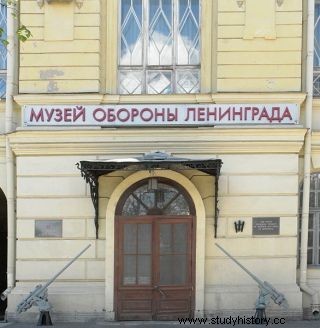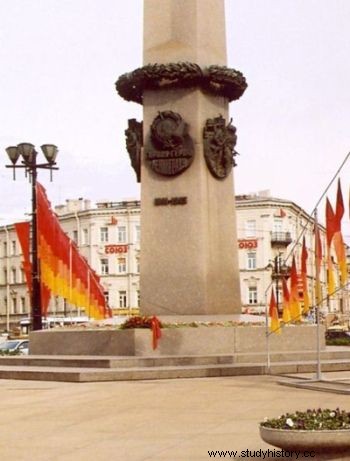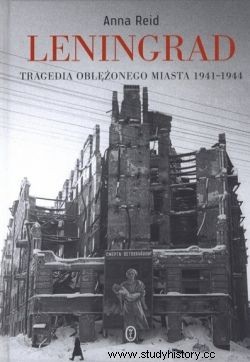Apparently, true hunger can be spoken of when a person views another human being as a meal ... When more than three million civilians were cut off in a ring around completely unprepared for the long defense of the city, it was known that it would end badly . In good winds, supplies could last for a month and a half. Then there was just a murderous hunger.
First a handful of information. On the Soviet side, the Blockade of Leningrad (i.e. today's St. Petersburg) lasting from September 8, 1941 to January 27, 1944, claimed about a million civilian casualties. Two-thirds of the population got a starvation ration of 125 grams of bread, or three thin slices. The daily ration was supposed to provide them with 460 calories, but these calories only existed on paper. In fact, by adding various fillers to the bread that you might not even think about, its nutritional value was reduced to about 300 calories, a tiny fraction of the daily energy requirement. The shimmering inhabitants of the once proud capital of the tsars were hungry to the limit. Their human reflexes were almost completely suppressed. They were completely stripped of their strength and dignity.
Man to man to wolf?
It quickly turned out that for many of them there were thousands of dead bodies lying on the streets it is not only the remains that should be mourned. This is quite a large supply of meat that cannot go to waste! In the besieged Leningrad, cases of cannibalism were not uncommon. Anna Reid, author of the book "Leningrad. The tragedy of the besieged city ”. In her work, we can find a quote from the memoirs of the famous Russian socialist poet, Olga Bergholc:

Does the Leningrad Defense Museum mention the cannibals marauding the city?
Prendel recently told us that the incidence of eating dead bodies is increasing . In May [1942], fifteen such cases were recorded in his hospital, compared with eleven in April. He then had to - and still has - to issue a specialist opinion as to whether the cannibals are responsible for their actions. Cannibalism is a fact. He told us about a couple of cannibals who first ate their baby's tiny body, then lured three more children into a trap, then killed and ate them […].
For most of the inhabitants of Leningrad at the time, these acts of anti-humanity were in the nature of rumors. Together with the others, they bent over the corpses lying in the streets and looked for signs of cannibalism. It is an undeniable fact that we find mutilated corpses in the city, with no calves or buttocks, or with traces of biting off. Based on the NKVD reports, Anna Reid lists:
a mother strangled her eighteen-month-old daughter to feed herself and her three older children ; some twenty-six-year-old, dismissed from the tire factory, murdered and ate his eighteen-year-old roommate [...] an unemployed eighteen-year-old murdered his grandmother with an ax, then cooked and ate her liver and lungs ...
Even this counting-out is chilling the blood in our veins ... However, we must not forget that they were once ordinary people, warm and kind to the environment, colleagues, relatives, who were brought to the extreme.

Stalin gave Leningrad the title of a city-hero. What after the titles and obelisks for those who have lost part of their humanity by eating their fellow man?
What about the dumped?
The students of Leningrad schools from outside the city were in the worst situation. Cut off from the support of the families that found themselves outside the ring that closed the former tsar's capital, they were at the mercy and disgrace of the directors of educational institutions. As Anna Reid writes:
At the Vocational School No. 39 at Mochowa Street, the students were left on their own. They had no supervision, and no food stamps were issued to them in December either. Throughout December, they ate the meat of cats and dogs caught and killed. On December 24, a student of Ch. he died of malnutrition, and his body was partially used as food by the other disciples. On December 27, another student of W. died and his body was also used for food. Eleven people were arrested for cannibalism, all pleaded guilty.
In Russian, there are two terms for eating human flesh that can be translated into Polish as death and cannibalism. They have different moral overtones. The first is to feed on the deceased homo sapiens while the second is murdering people and eating your victims. While the corpse was treated relatively gently (it is known, although it is still desecration of the corpse, but without transforming a living corpse into a corpse for consumption), the punishment for cannibalism was death.

The article is based mainly on the book "Leningrad. The tragedy of the besieged city ”by Anna Reid, which was published by WL.
"Aunt Nastia" cannibal
An example of such a person caught on cannibalism combined with murder is a cleaner described by Olga Grieczina. Her disappearance from the factory was easy to spot due to metal filings and other debris all over the place. They all referred to this absent old lady intimately "Aunt Nastio". Grechina learned that she had been shot. But for what? She ate her daughter - she hid her under the bed and cut her off piece by piece. The militia shot her. He doesn't go to trial these days.
Concrete stories could be multiplied. They reflect the horror of the situation and its hopelessness, but do not reflect the scale of the phenomenon. Within a dozen or so months, until December 1942, when this ill practice was put to an end, a total of over two thousand cannibals were arrested in Leningrad and its vicinity. But how many died without a trial? How many were never caught?
